Surfing in San Diego: A Beginner's Complete Guide
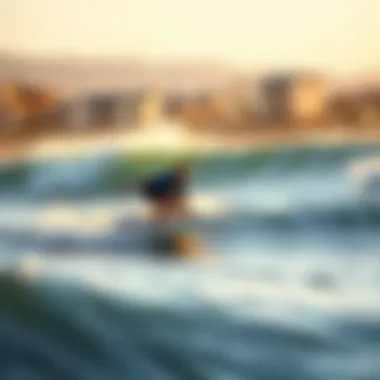
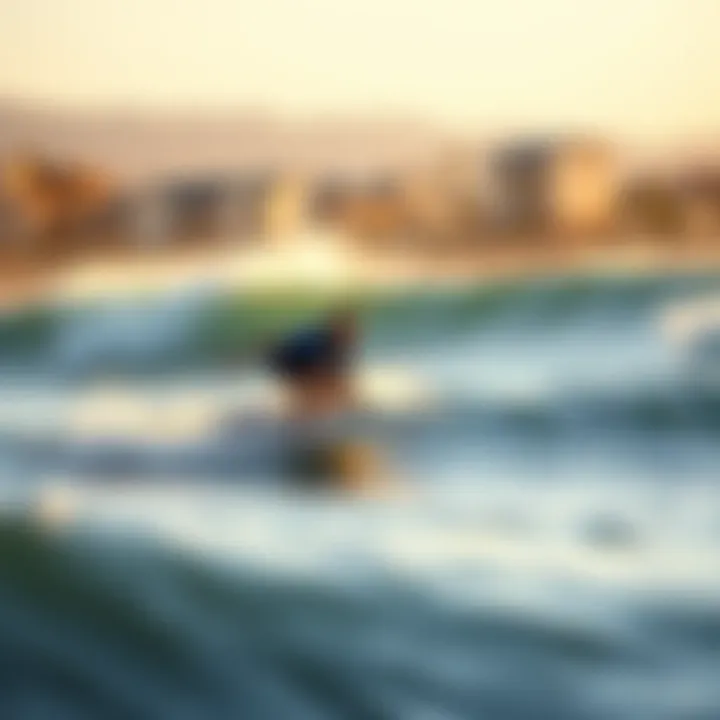
Intro
Surfing is more than just a sport; it’s a way of life. For those dipping their toes into the waves of San Diego, a vibrant coastal city known for its surf culture, there’s much to explore and embrace. From gentle beginner waves to challenging breaks, San Diego has something for everyone.
Before jumping into the ocean, it’s crucial to understand the essentials of surfing. This guide provides not only the basics but also delves deep into what makes surfing in this region special—equipment, techniques, safety, and community. By the end, you'll have a solid grasp on how to start your surfing journey and navigate the waters confidently.
Gear and Equipment
Latest Surfboard Technologies
Choosing the right surfboard is like picking the right dance partner; it can make or break your experience. Today’s surfboards are not just foam and fiberglass; they’re a blend of innovation and design meant to help beginners catch their first waves.
- Soft-top Surfboards: Ideal for beginners, these boards have a cushioned top that helps prevent injuries during falls—perfect for the less experienced.
- Hybrid Boards: These offer versatility, combining the paddle power of a longboard with the maneuverability of a shortboard. They're great for those still figuring out their style.
- Fish Boards: Known for their wide, shorter shape, fish boards are fantastic for smaller waves and can give beginners a smoother ride.
New advancements, such as lightweight materials and improved fin designs, make it easier to paddle, balance, and ride. It’s wise to visit a local shop—like the one at Pacific Beach—to get a feel for various boards before making a commitment.
Essential Accessories for Every Surfer
Once you have your board sorted, don’t forget the accessories. They might seem trivial, but the right gear makes for a safer and more enjoyable ride.
- Leash: A good leash keeps your surfboard attached to you and prevents it from becoming a hazard to others. Aim for one that’s durable yet lightweight.
- Wetsuit: Depending on the time of year and ocean temperature, a wetsuit may be necessary to keep warm and comfortable. Look for one that's flexible but snug.
- Surf Wax: This helps prevent slipping on your board. Without proper grip, you'll find yourself face-first in the water more often than not.
As you gear up, be mindful of local sources for purchasing or renting equipment. Websites like Surfer.com and forums on Reddit can offer insights into where to find the best deals or what’s trending in surf tech.
Surf Techniques and Skills
Beginner Surfing Techniques
Getting comfortable on a board takes practice, but some fundamental techniques can fast-track your learning curve.
- Paddling: This is the bread and butter of surfing. Knowing how to paddle effectively can mean the difference between catching the wave of your dreams or missing it completely.
- Pop-up: The transition from lying down to standing on your board is where many beginners struggle. Focus on timing and body movement. A solid pop-up technique is crucial.
- Wave Positioning: Understanding where to position yourself to catch waves can save you a lot of frustration.
Advanced Maneuvers for Experienced Surfers
As you grow more comfortable on the board, there will always be room for improvement.
- Cutbacks: This technique involves turning back towards the wave after gaining some speed. It's a great way to maintain momentum.
- Floater: Riding over the crest of a breaking wave requires balance and positioning, but it’s a flashy move that gets noticed.
- Aerials: For those who are more adventurous, jumping off the wave and landing back on it is sure to turn heads.
Mastering these skills takes time, but with persistence and patience, you'll see progress. Take some lessons from local surf schools across San Diego, like Surf Diva or the San Diego Surf School, where experienced instructors can guide you through the basics and beyond.
"Surfing is the most fun you can have without taking your clothes off."
Ending
Surfer or not, the essence of riding the waves is about finding balance, patience, and community. As you embark on this surfing journey in San Diego, remember that every expert was once a beginner. With the right equipment, techniques, and a dash of enthusiasm, the Pacific waters await. The local surf culture is rich and welcoming, offering an experience filled with camaraderie and respect for the ocean.
Overview of Surfing in San Diego
Surfing in San Diego isn't just a pastime; it’s a way of life for many. The unique blend of beautiful landscapes, consistent waves, and vibrant surf community make it an ideal spot for surfers of all skill levels. For beginners, this city offers not only breathtaking views but also a rich tapestry of resources that can guide them through their initial surfing experiences.
The ocean has a way of humbling and challenging those who enter it. It requires respect, understanding, and a certain level of dedication which can be overwhelming for someone just dipping their toes into the surf culture. That’s why understanding the basics about surfing in this iconic location is crucial.
This section is important because it sets the stage for novices, providing a contextual backdrop that includes essential facts, historical significance, and local culture. By exploring these elements, beginners can develop a core appreciation that enhances their overall surfing journey in San Diego.
A Brief History
Surfing has a long and interesting history in San Diego. The area has been a surf haven since the early 20th century, attracting not only locals but also travelers who are keen on riding the waves. It’s said that in the 1910s, the first surfers in the region were influenced by Hawaiian culture, bringing back their passion for the ocean.
There’s a captivating story about a group of surfers in the 1930s who pioneered the sport, carving out boards from local redwood trees. Fast-forward to the sixties and seventies, and you’ll find San Diego at the heart of the surf revolution in California. With the advent of modern surfboards and the explosion of surf culture in movies and music, a local surf scene blossomed, inspiring generations to take it up.
This rich historical backdrop doesn’t just give context; it instills a sense of belonging. When beginners realize they are part of a long-standing tradition, it enriches their surf experience immensely.
Significance in Surf Culture
The significance of surfing in San Diego goes well beyond the act of riding waves. It’s about connection—connection with nature, connection with fellow surfers, and connection within the community. The beaches are often the gathering spots, where stories are shared, friendships are built, and the thrill of catching waves turns into a lasting bond.
Moreover, San Diego serves as a melting pot of surf styles and techniques, influenced by various surf schools and professional surf competitions. Whether you're zipping down at La Jolla Shores or perfecting your skills at Pacific Beach, you contribute to the ongoing narrative of surf culture.
It’s also worth noting the environmental consciousness that has been integrated into the surf lifestyle in this area. Surfers in San Diego are often at the forefront of ocean conservation efforts, understanding that a healthy ocean is fundamental to maintaining the sport.
As you venture into this spectacular world, the significance of San Diego's surf culture becomes apparent. It invites you not just to learn how to surf but to embrace a lifestyle that appreciates waves, wildlife, and the communities that thrive along the coastline.
As surfing evolves, so does its impact on local culture, community, and the environment. Embracing this can enhance your journey both on and off the board.
Identifying the Best Surf Spots
When it comes to surfing, where you choose to hit the waves can make all the difference. Especially for beginners, picking the right surf spot is crucial not just for safety, but also for enjoying the learning experience. Each beach offers its own unique conditions, challenges, and vibe, which is why knowing the best surf spots in San Diego is non-negotiable for any budding surfer.
The ideal surf spot will have manageable wave heights, gentle breaks, and ample space to practice. Starting at a spot that caters to beginners helps build confidence, so the significance of selecting the right location cannot be overstated.
La Jolla Shores
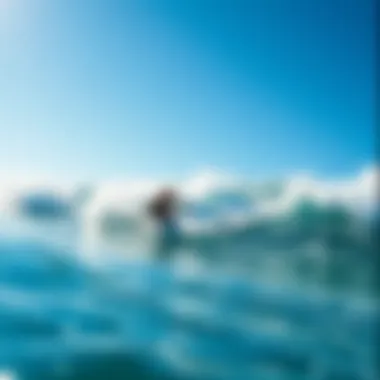
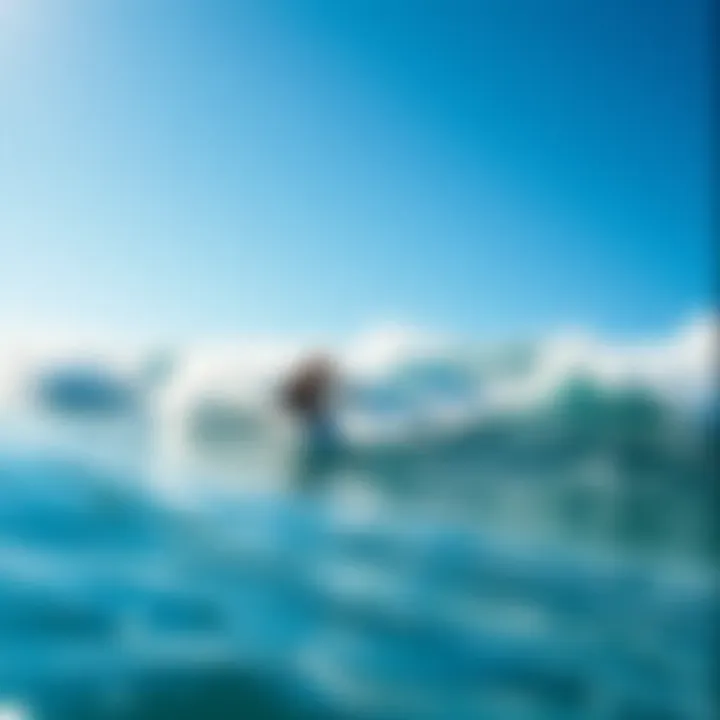
La Jolla Shores is one of the most celebrated beginner-friendly surf spots in San Diego. The beach stretches about a mile long, offering soft sand and small, consistently breaking waves that are perfect for newcomers. The gentle slope of the ocean floor further enhances its appeal, as it allows surfers to paddle out with relative ease.
Here, you can find various surf schools lining the beach, making it convenient to grab a lesson. The atmosphere is notably friendly, and the local surf culture embraces newcomers with open arms. To top it off, the picturesque backdrop of La Jolla cliffs makes even those wipeouts feel less daunting. Don't forget to check the local surf reports; during the summer, the waves tend to be smaller, which is ideal for practice.
Pacific Beach
Pacific Beach, often called PB by the locals, offers a lively surf scene and proves inviting for surf novices. The beach boasts a long stretch of sandy shore, where the waves vary throughout the year. Beginner surfers are best off closer to the northern end of the beach where the waves tend to be smaller and more manageable.
One notable aspect of Pacific Beach is the vibrant community atmosphere. Here, you’ll find surf shops renting out equipment, and you might even bump into a fellow surfer willing to offer a tip or two.
However, keep in mind that the busy environment might be overwhelming at first, but that just adds to the excitement. Watching seasoned surfers navigate the bigger waves down south can still provide inspiration as you hone your own skills.
Mission Beach
Mission Beach combines a great surf experience with an active beach life. The waves might not be as consistent as La Jolla or PB, but it's still an excellent spot for beginners. The wide sandy beach creates an inviting atmosphere, and the gentle waves typically make for a more relaxed surfing experience.
More importantly, Mission Beach is known for its community vibes, where a laid-back atmosphere prevails. You’ll also find several surf schools in the area, so if you want to take a lesson, it can be easily arranged. Don't forget to enjoy the boardwalk after your session; it’s a great place for some post-surf snacks or simply soaking in the sun.
Trestles
While Trestles might not be the first spot that comes to mind for beginners, it's worth mentioning for its proximity. Located just a bit farther north in San Clemente, Trestles is primarily famous for its world-class waves and expereinced surfers.
However, it also has sections that can cater to beginners when the conditions are right. The sandy bottom and low current areas allow newcomers the chance to find their footing. When conditions are off, beginner surfers can still benefit from watching seasoned surfers at Trestles as they navigate the challenging waves; it’s a learning experience in its own right.
In closing, selecting the right surf spot is a crucial first step on your surfing journey in San Diego. Each of these beaches offers essential lessons and experiences, combined with a nurturing environment that helps you develop your skills and enjoy the waves.
Essential Surf Equipment for Beginners
When stepping onto the waves, having the right surf equipment is like bringing a knife to a gunfight — it can mean the difference between success and struggle. Choosing equipment that fits well with your skill level, along with a thorough understanding of what you'll need, can make your first experience in the ocean both enjoyable and safe. But it’s not just about having gear; it's about having the right gear.
This section highlights fundamental components like surfboards, wetsuits, and accessories that beginners should consider as they gear up for their surfing adventure.
Choosing the Right Surfboard
Selecting the ideal surfboard is a pivotal part of your journey. It serves as your trusty steed in a world of waves, so getting this right is essential.
Soft-top vs. Hard-top
When it comes to surfboards, the debate between soft-tops and hard-tops can be quite a head-scratcher. Soft-top boards are often recommended for beginners due to their forgiving nature. They tend to be more buoyant, making it easier for novices to catch waves. Furthermore, the extra padding reduces the risk of injury, which is crucial when you're still finding your sea legs. On the flip side, hard-top boards are a favorite for more advanced surfers. They offer better performance in terms of speed and maneuverability, but can be tricky for a beginner to handle due to their rigidity.
In essence, for the novice surfer, soft-tops are the way to go. They provide a gentle introduction to the sport while still holding their own in terms of ride quality.
Size Considerations
Size does matter when you’re choosing a surfboard, especially for beginners. A larger board can be more stable and easier to paddle. Think of it as a sturdy foundation; the bigger it is, the easier it is to stay balanced. The key characteristic to keep in mind is a board that’s about 8 to 9 feet long for most newcomers. This size is less likely to sink and can help you catch waves more efficiently. Meanwhile, a smaller board might be appealing for its speed and maneuverability but could spell disaster for a beginner struggling to maintain stability.
So, when looking at size, remember that a longer, wider board typically offers greater volume, ensuring that you stay afloat and can navigate those pesky breaks more effortlessly.
Wetsuits and Accessories
Once you've sorted out the board, the next item on your shopping list should be a wetsuit. This piece of equipment plays a crucial role in keeping you warm and protected in the ocean's chilly waters.
Types of Wetsuits
Wetsuits come in various flavors, each designed for specific water temperatures and surfing conditions. The most common types include spring suits, which are short-sleeve for warmer days, and full suits, that cover your arms and legs for cooler waters. The thickness of the neoprene material varies, with 2/2mm suits being great for warmer climates like those in San Diego, while 4/3mm or thicker suits could be necessary when the mercury dips.
Choosing the right type of wetsuit is advantageous. A well-fitted wetsuit allows for flexibility and comfort when paddling out, yet provides enough insulation to keep you warm, making it easier to spend more time in the water without shivering.
Necessary Accessories
Every surfer knows that a few must-have accessories can make a huge difference. A surf leash is essential; it connects you to your board, ensuring that when you wipe out, your board doesn’t drift off into the sunset. In addition, wax is crucial for keeping your grip on the board. Depending on the season, you might also consider booties for your feet, especially in winter when the water gets more chill.
So, before you hit the beach, gather these must-have accessories. They might be small, but they pack a punch when it comes to elevating your surfing experience.
Learning to Surf
Learning to surf is a significant step for any beginner wishing to dive into the waves, especially in a vibrant surfing locale like San Diego. This section explores not just techniques, but also the learning curve that is both exhilarating and, at times, a bit daunting. By understanding how to surf effectively, beginners can improve their skills while also minimizing risks associated with the sport.
Finding Surf Lessons
Local Surf Schools
Local surf schools are an excellent stepping stone for novices. They offer structured lessons that cater to beginners, making it easier to grasp the fundamentals of surfing. Most of these schools operate right at popular beaches, allowing students to hop right into the water and get a feel for the ocean.
A key characteristic of these schools is the group setting, where participants can learn not only from instructors but also from peers, sharing their experiences and cheering each other on.
However, one downside could be the variance in instructor quality. With group classes, sometimes the attention a student receives may not be as focused compared to one-on-one instruction. You might get stuck in a class with different skill levels, which can be frustrating for someone just starting. In the end, schools like the "SoCal Surf School" or "Surf Diva" in La Jolla are worth their salt for quality instruction.
Private Instructors
For beginners who prefer a more tailored experience, private instructors provide personalized coaching. This one-on-one attention can significantly speed up the learning process, particularly for individuals who may feel self-conscious about learning in a group environment. Private lessons often allow flexibility in lesson timing and can be customized to fit specific skill goals or techniques.
The unique feature of private instruction is that surfers can receive immediate feedback and tailored guidance. This can be especially beneficial when learning to tackle specific problems, like struggling to paddle efficiently or manage board balance. However, these lessons often come with a steeper price tag compared to group classes.
Basic Techniques
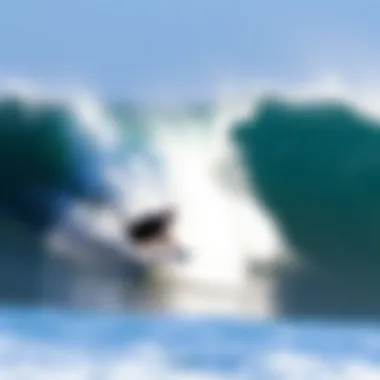
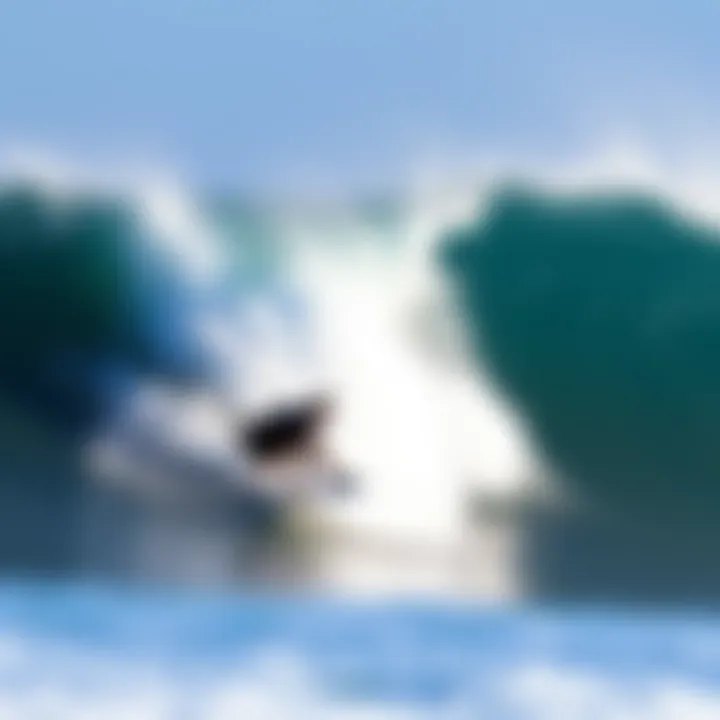
Paddling and Positioning
Paddling and positioning are foundational skills that every budding surfer must master. This aspect of surfing determines how efficiently a surfer can catch a wave and stay afloat. Proper paddling technique is vital; using the correct stroke can give you the momentum needed to ride those waves successfully.
It's essential to practice positioning on the board, as uneven weight distribution can lead to tumbles. The great thing about mastering paddling and positioning is that it greatly increases your chances of catching waves, and often, practice makes perfect.
However, be mindful that this can be physically demanding at first. Fatigue can set in quickly, especially for those not accustomed to extensive upper body workouts. So, a bit of patience is needed here.
Standing Up on the Board
Once you’ve nailed paddling and positioning, the next hurdle is standing up on the board. This maneuver is often where beginners face the most challenges. Getting from a prone position to standing is no small feat; it requires balance, timing, and a good sense of the wave's movement.
The key characteristic of this technique lies in form and timing. Learning to pop up quickly and efficiently can greatly enhance your ability to ride waves. This technique is a rite of passage in surfing, and, when done correctly, allows for an exhilarating experience.
However, it might take multiple tries before getting it right, and many new surfers feel discouraged if they don’t succeed quickly. Having a mentor or instructor nearby can ease this process significantly. The feeling of finally standing up and riding a wave is indescribable and solidifies one's commitment to the sport.
Understanding Ocean Conditions
Understanding ocean conditions is essential for anyone looking to hit the waves. It's like knowing the rules of a game before stepping onto the field. As a beginner surfer, this knowledge helps to ensure safety, enhance enjoyment, and improve your skills on the water. The ocean can be unpredictable, so recognizing how to assess the conditions will put you in the best position to ride your first waves confidently.
Reading Waves
Wave Types
When it comes to surfing, not all waves are created equal. There are different types of waves, and each has its own personality. The primary categories include beach breaks, point breaks, and reef breaks. Beach breaks are often favored by beginners since they provide softer waves that are easier to ride. A key characteristic is that these waves break over sandy bottoms, reducing the risk of injury.
- Beach Breaks: These are great for learning because they are accessible and generally have consistent waves. Ideal for beginners to practice.
- Point Breaks: These tend to have longer, cleaner rides, which can be thrilling for surfers, but are often a bit more challenging due to their shape and take-off spots.
- Reef Breaks: Known to produce some of the best waves, they can also be more dangerous due to hard coral or rocks. Not advisable for beginners.
Choosing the right type of wave is crucial for experiencing satisfaction in your surfing journey. Focusing on beach breaks allows novices to build confidence without the risks posed by more complex waves.
Rip Currents
Rip currents are powerful, narrow channels of water that flow away from the shore. Understanding them is like having a secret map to safe surfing. Beginners should prioritize learning how to identify rip currents and how to safely escape them if caught.
Rip currents typically occur in open areas where waves break, then retreat, creating a channel of fast-moving water. Their significant characteristic is that they can pull even strong swimmers out to deeper waters quickly. It's important to note:
- Safety First: Learning how to spot rip currents can save lives. Look for gaps in breaking waves, water that seems darker, or foam moving away from the shore.
- Communicate: Tell your surf instructor or fellow surfers if you notice a strong current.
Although rip currents sound intimidating, understanding them can lead to a more enjoyable and safe surf experience. Knowing how to handle these currents prepares you mentally and physically to face the ocean.
Weather Influence on Surfing
Weather plays a pivotal role in surf conditions. Wind, rain, and tides all contribute to the quality of the waves you can expect.
- Wind Direction: Offshore winds tend to create cleaner waves, ensuring they maintain their shape longer. Conversely, onshore winds can create choppy and less suitable conditions.
- Temperature and Rain: Warm weather generally means more people at the beach, affecting wave quality due to increased crowds and potential disturbances in the water. Heavy rains can change river flows, which in turn influence local surf patterns.
Monitoring weather forecasts and knowing local conditions can keep you informed about what to expect each day you hit the beach. Surfers should consider local apps or websites that offer user-friendly updates to find the best conditions.
With these tools in hand, you'll be better equipped to choose your surfing days wisely, leading to more rewarding experiences on the water.
Safety Considerations
Surfing, while exhilarating, can also pose certain risks, especially for beginners. Understanding safety considerations is paramount for diving into this thrilling sport. By being aware of the potential dangers and the established practices, you not only protect yourself but also create a more enjoyable experience for everyone in the water. Safety should always take precedence over the thrill of riding waves.
Understanding Surf Etiquette
When you step into the ocean with your surfboard, you might notice a unique unwritten code among surfers. Surf etiquette is vital for maintaining harmony in the lineup and ensuring that everyone has a fair chance to enjoy the surf. Here are some key points:
- Right of Way: The surfer closest to the peak of the wave has priority. If you’re further down the line, it’s generally seen as courteous to not paddle for that wave.
- Avoid Snake Moves: Don’t drop in on someone else’s wave. It can cause collisions and escalate tensions.
- Respect Others: Give room to fellow surfers and never paddle through crowded lineups. It’s common courtesy to wait your turn.
- Communicate: Whether it's waving a hand or making eye contact, let others know your intentions. It simplifies everything.
By adhering to these practices, you showcase respect for fellow surfers and create a positive environment that in turn enhances your own experience.
Dealing with Injuries
With all the excitement that surfing brings, sometimes things can go awry. Dealing with injuries is a critical component of safety. Here are some considerations:
- Know the Basics of First Aid: Have a basic understanding of first aid. If someone falls and sustains an injury, being knowledgeable can prevent further complications. Simple measures like applying a band-aid or treating scrapes can go a long way.
- Recognize Common Injuries: From sprains to the occasional bruising, knowing what to look for can help you react appropriately. If you notice someone struggling, assess the situation carefully before offering assistance.
- Seek Help When Necessary: If injuries are serious, knowing when to call for professional help is essential. Don’t hesitate to reach out to lifeguards or medical personnel on the beach.
Being prepared for injuries enhances your confidence in the waves. The ocean is a dynamic and powerful environment, and understanding both etiquette and safety can ensure that your surfing journey is enjoyable and secure.
Embracing Local Surf Culture
Surfers know that riding the waves is about more than just catching a swell—it's about the rhythm, the friendships, and the lifestyle intertwined with the ocean. Embracing local surf culture in San Diego means integrating oneself into a vibrant community that thrives on camaraderie, respect, and the pure joy of surfing. For beginners, understanding and becoming part of this culture can greatly enhance the surfing experience.
The San Diego surfing community is deeply rooted in traditions that reflect a unique mix of influences from both California's surf history and the diverse local culture. From the laid-back vibes of beach bonfires to early morning dawn patrols, every moment spent with fellow surfers can teach newcomers valuable lessons not only about surfing but also about the ethos that governs interactions within the surf world.
Benefits of Embracing Local Surf Culture
- Building Connections: Joining a community of surfers helps beginners form friendships and networks that elevate their skills and confidence. It’s not just about the boards; it’s about the people who share the experience.
- Learning Local Knowledge: Local surfers often have the best insights on conditions, spots to avoid, and the best swells for beginners. Getting to know them can lead to invaluable learning opportunities.
- Invitational Opportunities: Many local events and gatherings are typically focused on inclusivity and welcoming newcomers, giving budding surfers chances to participate.*
Considerations
Engaging with the local surf culture requires an open mind and readiness to absorb the social cues and etiquette that come with it. Respect is the name of the game—whether it’s waiting your turn in the lineup or acknowledging the sanctity of a local spot, every interaction counts. Additionally, learning a few surf lingo terms can speak volumes. Casual phrases like "take off" or "caught inside" will not only earn respect but also help new surfers blend in.
"Surfing is the most blissful experience you can have on this planet, a taste of heaven.�"
— Jack O'Neill
Connecting with the Community
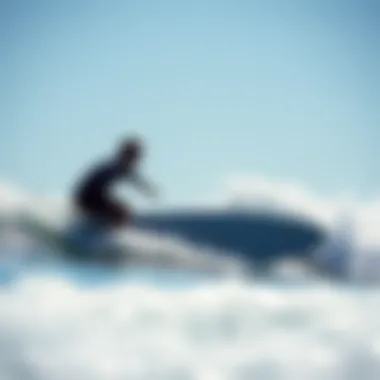
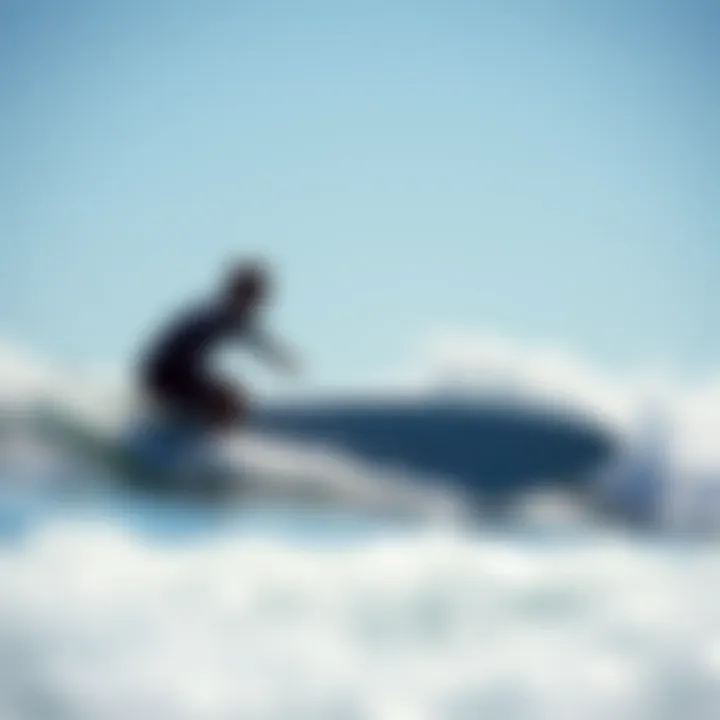
Getting involved with the San Diego surf community can begin simply by visiting the local beaches. Join a surf school, or even just chat people up as you wait for a wave. This grassroots approach often leads to friendships that blossom over shared laughs and wiped-out attempts in the water. A sense of belonging can ease the challenges every beginner faces.”
- Attend Meetup groups or join forums on sites like Reddit where surfers converse and share tips on handle local surf conditions.
- Volunteer or Participate in beach cleanups organized by local surf clubs. This fosters not only community ties but also a sense of responsibility towards preserving the beautiful waves you’ll be riding.
Surf Events and Competitions
San Diego is alive with various surf events that cater to every level, from bustling competitions to laid-back gatherings. Attending these can be a game-changer for beginners.
- Competitions: Events like the US Open of Surfing or smaller local contests provide an eye-opening experience where you can see skilled surfers in action. Watching their techniques up close can inspire and educate you on maneuvers.
- Local Gatherings: Many surf shops or organizations regularly host surf contests or "fun days" that invite all skill levels to join. These occasions often bring together beginners and local pros, fostering a supportive environment.
- Community Festivals: Celebrations like the La Jolla Shores Surf Festival present opportunities to connect with like-minded surf enthusiasts while enjoying live music, food, and surf-related activities. Keep an eye on local calendars or social media pages for upcoming events.
- Check out the schedule on websites like World Surf League to stay updated on major surf events.
By getting involved, learning from others, and sharing experiences, beginners can find valuable camaraderie and support—a vital part of becoming a mean-to-mean surfer in San Diego’s iconic surf culture.
Navigating Surfing Etiquette
Surfing isn't just about catching waves; it’s a culture steeped in its own unique set of rules and norms. This etiquette is crucial for ensuring that everyone, from novices to pros, can enjoy the ocean without conflict. Understanding these unwritten rules is essential, particularly for beginners in San Diego who might not yet be familiar with the local surf scene. Good etiquette fosters a sense of community, minimizes accidents, and enhances the overall surfing experience.
Understanding Right of Way
In the lineup, knowing who has the right of way is fundamental for safe surfing. The general rule is simple: the surfer who is closest to the peak of the wave has priority. This means if you are paddling for a wave and you see someone already in position, it's best to back off. When the delicate balance of priority is respected, it prevents collisions that could lead to injuries for the surfers involved.
When you’re just starting out, it might seem daunting. But hey, every pro surfer was once a beginner! Just keep your eyes peeled and be aware of your surroundings, so you can get the hang of who’s where. Local surfers will usually exhibit signs or gestures to indicate their intentions, so learn to read these cues.
Here's a quick rundown of tips to keep in mind:
- Stay aware of your surrounding surfers.
- Paddle for waves that you're sure you can catch without cutting off someone else.
- Use hand signals to communicate if needed, like waving back to indicate that you're yielding.
- If you're unsure, better to let it go than to risk a mishap.
Communicating with Other Surfers
Communication in the water goes beyond mere words; it’s almost a silent language that seasoned surfers understand. A friendly nod or wave can signify camaraderie and intention. When you’re paddling out, greet fellow surfers; a simple smile can help break the ice. As a newbie, acknowledging others shows respect and readiness to learn from them.
It can also help to verbally communicate when you're in a tight spot. If you find yourself about to take a wave, shout "Coming in!" or "Dropping in!" This lets everyone know you’re on your way down, helping avoid any close calls. Here are a few phrases that might come in handy:
- "Paddle harder!" (When someone needs to catch a wave)
- "Go ahead!" (When yielding the right of way)
- "Watch out!" (If a wave is coming at someone unexpectedly)
In summary, make sure to keep your body language open and inviting. Respect is the name of the game, and with a little bit of practice, you'll navigate the waters and the surfers with ease going forward.
"Respect is everything in the lineup; lose it, and it can ruin the mood on the water."
By embracing these elements of etiquette, beginners can integrate into the local culture smoothly and enjoy their surfing journey in San Diego. Don’t worry, practice will make you more comfortable, and soon you’ll feel right at home amongst the waves.
Post-Surf Care
After catching those waves and riding the swell, post-surf care becomes an essential part of your routine. It's not just about feeling good; it's about ensuring your body and gear are ready for the next session. Neglecting post-surf care can lead to injuries, equipment issues, and might even dampen your enthusiasm for the sport. In San Diego, where surfers often hit the waves all year round, being mindful of these aspects can elevate your surfing experience.
Equipment Maintenance
Taking care of your surfboard and gear should sit high on your priority list. Here are essential maintenance practices to consider:
- Rinsing Your Board: After surfing, rinse your board with freshwater to remove any salt, sand, or debris. This helps maintain the integrity of the board and prevent corrosion, especially for your fins and leash.
- Inspecting for Damage: Check for dings or cracks. Even minor damages can worsen if not addressed. Use a repair kit, which typically contains resin or a patch kit, for swift fixes.
- Drying Properly: Let your board dry in the shade to avoid damaging the fiberglass from direct sunlight. Lean it against a wall or place it on a soft surface to keep it safe.
- Storing Gear Correctly: Keep your wetsuit and accessories in a cool, shaded area. Hanging your wetsuit can minimize stress on the fabric, while storing it crumpled can lead to lasting creases.
These simple practices can prolong the life of your equipment, saving you money in the long run.
Self-Care After Surfing
Your body deserves just as much attention as your gear. After spending hours paddling and riding waves, your muscles and skin may need some TLC. Here’s how to ensure your body feels its best:
- Hydration: Replenish fluids lost from surfing. Water is crucial, but electrolyte drinks can help restore lost minerals, especially after extensive sessions.
- Stretching and Recovery: Take a few minutes to stretch your limbs. Focus on your shoulders, back, and legs to reduce muscle stiffness. Consider practicing yoga or using a foam roller to assist in recovery.
- Skincare Routine: Sun exposure can lead to burns and dryness. Apply a good moisturiser after bathing to keep your skin hydrated. Don’t forget the sunscreen for next time, too!
- Rest and Nutrition: Listen to your body. Give yourself time to recover and maintain a balanced diet to fuel your next surfing adventure. Foods rich in protein and healthy fats can offer the rejuvenation your muscles need.
"Remember, whether it's repairing your gear or taking care of your body, the time spent in preparation is just as vital as the time spent on the waves."
By integrating effective post-surf care into your routine, you'll not only enhance your performance but also keep the joy of surfing alive. Surfing is not just a sport; it’s a lifestyle. Realizing that taking care of yourself and your gear is part of that lifestyle can lead to many more satisfying days on the water.
Continuing Your Surf Journey
As any seasoned surfer will attest, the journey into surfing doesn’t often conclude after the first few waves. The waters of San Diego offer a wealth of opportunities for progress and personal expression on the board. Continuing your surf journey is not merely a practical concept but rather a vital part of immersing yourself in the sport's culture and lifestyle. Growth in surfing is like peeling an onion; as you advance, there's always another layer of skills, techniques, and experiences to discover.
The importance of setting a path for your continual improvement cannot be understated. It keeps the thrill alive and makes you hungry for those wave-riding moments. When you set goals, you lay down stepping stones that help you track your progress and dive into challenges that sharpen your skills.
Setting Goals
Setting goals in surfing is akin to crafting a blueprint for a house. Without one, you might find yourself wandering aimlessly like a lost surfboard in the tide. A clear set of objectives caters not just to your skill enhancement but also to your experience overall. Here are a few key points worth considering when setting your surfing goals:
- Skill-specific Goals: Focus on mastering particular skills, like paddling faster or executing a proper bottom turn.
- Time-focused Milestones: Committing to a certain number of surf sessions each month can elevate your experience. Aim for consistency.
- Surfing with Others: Challenge yourself by organizing or joining group sessions, which can help you learn from others while building camaraderie.
"Setting clear goals is the compass that directs your surfing journey, guiding you through the waves and beyond."
These goals create measurable checkpoints throughout your surfing experience. Once you've scratched the surface, new challenges await you. Want to go toe-to-toe with locals at Trestles? Your aspirations fuel your drive, making each session richer.
Exploring Advanced Techniques
Once you’ve established a solid base and reached certain personal milestones, it’s time to dip your toes into advanced techniques. This stage is where many surfers find their unique style and connection to the board. Exploring higher-level skills not only heightens your surf game but makes each ride more exhilarating. Here’s what you can focus on:
- Carving and Cutbacks: These techniques allow for fluid transitions as you navigate waves, making them look effortless.
- Aerial Moves: While they require practice and confidence, they can add a level of creativity to your surfing.
- Board Variety: Experimenting with different types of boards, like fish or longboards, can introduce you to new styles and techniques.
By tackling these advanced techniques, you reignite your passion for surfing while discovering new avenues of expression. The ocean has a way of teaching you humility, and as you grow, you'll appreciate the beauty of mastering these skills amidst ever-changing conditions.
While your path in surfing might look different from others, what matters is that you are continuously evolving and challenging yourself. Whether you’re setting goals or delving into advanced techniques, every step you take is a wave worth riding.







